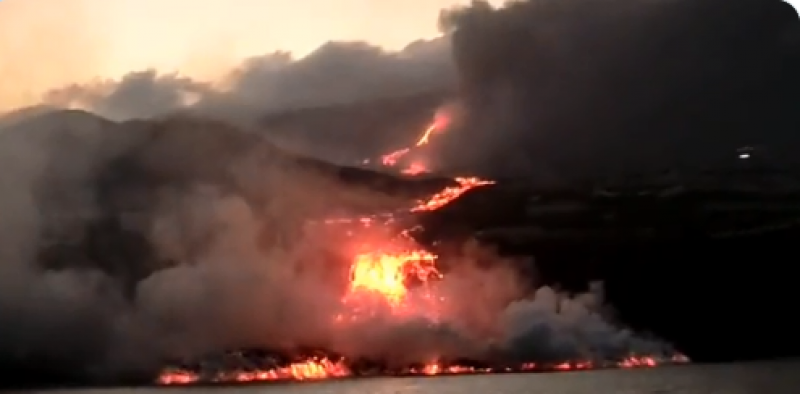Date Published: 01/10/2021
ARCHIVED - Latest on La Palma: New lava flow from volcano threatens more homes
Experts fear that the second stream of lava on the Canary Island will deteriorate air quality

A new fissure opened up on the north face of the Cumbre Vieja volcano on the Canary Island of La Palma shortly before midnight on Thursday night, September 30, sending another wave of lava cascading down the mountain. With this new volcanic activity, there are now two active streams of magma, one in the south and one in the north, putting even more lives and homes in danger. According to the Geological and Mining Institute of Spain (IGME), the runoff from the new fissure is heading towards the previously unaffected areas of the municipalities of El Paso and Los Llanos.
Vídeo de la erupción y el río de lava a las 10.30 h (hora canaria) / Video of the eruption showing the lava river at 10.30 a.m. (Canarian time) #lapalma pic.twitter.com/USVZbCS11f
— INVOLCAN (@involcan) September 30, 2021
One of the biggest worries for volcanologists is that the fissures continue to display different types of eruptive behaviour, making them very unpredictable and thus their paths are difficult to plot. At the moment, the huge amount of magma produced last night has caused the main stream to overflow, thus there are now two separate courses making their way to the sea. This means that the destructive path of the eruption has been extended, and scientists have concluded that the lava has now spread across 338 hectares of land, destroying more than 870 buildings. In addition, the ash has settled over 3,172 hectares of the island.
Vídeo a las 10.00 h (hora canaria) tomado por nuestros compañeros en el campo. Nuevo foco de emisión y nueva colada de lava / Video at 10:00 am (Canarian time) taken by our colleagues in the field. New focus of emission and new lava flow #erupcionlapalma #lapalmaeruption #lapalma pic.twitter.com/N5I9nOW1VA
— INVOLCAN (@involcan) October 1, 2021
In the meantime, the path which was opened up on the coast of Tazacorte on Tuesday night continues to send a lava waterfall cascading into the ocean, and the chemical reaction between the scorching volcanic matter and considerably cooler sea water has resulted in the formation of an enormous landmass which is already 400 metres wide and 50 metres high.
The toxic cloud of gas and water vapour generated by the contact of the lava with the sea is still at the forefront of the minds of residents and authorities alike, with officials asking for “maximum precaution.” More than 4,600 residents of the coastal town have been confined to their homes, with those living in nearby municipalities being warned to keep their distance from the exclusion zones. Experts are continuously monitoring the air quality on the island, of course, and so far the readings are reassuring as the prevailing winds carry the fumes out to sea.
Nuevas imágenes del delta de lava a las 16.40 (hora canaria) / New images of the lava delta at 16.40 (Canarian time) #erupcionlapalma #lapalmaeruption #lapalma pic.twitter.com/aQxrI1WyNS
— INVOLCAN (@involcan) September 30, 2021
However, the experts have warned that La Palma isn’t out of the danger zone yet, as the second stream of lava searching for a route to the sea could cause the coastal path to widen even further, which would generate an even bigger toxic cloud.
Images: Involcan
Contact Spanish News Today: Editorial 966 260 896 /
Office 968 018 268



























